Veterinary medicine is a fascinating field where technology plays a crucial role in diagnosing and treating our beloved pets. Advancements in imaging technology have revolutionized the way veterinarians examine animals, providing detailed and accurate information about potential health issues. One of the most widely used and effective pieces of equipment today is the veterinary CT scanner. Let’s delve deeper into this equipment and its relevance in the veterinary field.
If you wish to view the high-end product catalog that we have for you at KALSTEIN, visit us at https://kalstein.eu/categorie-produit/veterinary-sector/veterinary-ct-scanner/?lang=en We assure you that through our online PURCHASE channels it’s very easy and feasible to find the best MARKET PRICES, reminding you that we are a MANUFACTURER of high-level Laboratory Equipment for SALE. https://kalstein.eu/?lang=en
What is a Veterinary CT Scanner and How Does it Work?
The CT scanner, or computed tomography, is an imaging device that uses X-rays to create detailed 3D images of a patient’s internal anatomy. Veterinary CT scanners are specially design for animals, allowing veterinarians to obtain high-resolution images of tissues, organs, and bones.
The operation is quite similar to a human CT scanner. The patient is placed on a table that slides into a ring containing X-ray detectors. These detectors rotate around the patient, capturing multiple cross-sectional images later combined to form a detailed 3D image.
Benefits of Veterinary CT Scanners for Diagnosis
Veterinary CT scanners offer significant advantages for veterinarians in diagnosing and treating animals:
- Detailed Images: CT scanners provide detailed 3D images, allowing veterinarians to precisely examine an animal’s internal anatomy and detect potential health problems.
- Accurate Diagnosis: Thanks to high resolution, these scanners aid veterinarians in making more accurate diagnoses and establishing appropriate treatment plans.
- Surgical Planning: CT scanners are invaluable tools for planning surgeries as they allow veterinarians to visualize anatomical structures and plan interventions more effectively.
Applications of Veterinary CT Scanners in Practice
Veterinary CT scanners have a wide range of applications in veterinary practice, including:
- Tumor Detection: They can be use to detect tumors, their size, and location within the animal’s body, crucial for establishing a suitable treatment plan.
- Trauma Evaluation: In cases of trauma or injury, veterinary CT scanners are invaluable for assessing injury severity and determining the best therapeutic approach.
- Chronic Disease Management: For chronic diseases like arthritis or hip dysplasia, CT scans can be use to monitor disease progression and adjust treatment as needed.
Important Considerations When Using a Veterinary CT Scanner
While a powerful tool, there are important factors to consider:
- Radiation: Due to X-ray use, minimizing animal exposure is crucial. Veterinarians follow safety protocols and use appropriate radiation doses for each case.
- Staff Training: Veterinary staff operating the CT scanner need proper training and experience interpreting the obtained images.
Progressing Towards More Accurate Diagnosis
Its high resolution, ability to make accurate diagnoses, and wide range of applications make it indispensable for diagnosing and treating diseases in our furry friends. As technology continues to evolve, the veterinary CT scanner will continue to play a fundamental role in advancing veterinary medicine towards a more accurate and effective approach to animal healthcare.

